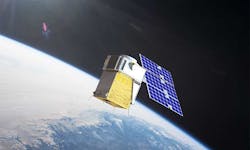Doug Mohney is the of Editor in Chief of Space IT Bridge, which tracks the business of space-based satellites. He has been working in and writing about IT and satellite industries for over 20 years.
As the cost of building and launching satellites continues to drop, melding IT concepts with satellite operations to bring data center services into Earth orbit and beyond is emerging as the next big thing.
Colocation of server hardware, virtually running applications in the cloud, and edge computing are all familiar concepts to the data center world, but the space industry wants to apply those ideas into satellite-based business models.
Until recently, satellite hardware and software were tightly tied together and purpose-built for a single function. The introduction of commercial-off-the-shelf processors, open standards software, and standardized hardware is enabling companies to repurpose orbiting satellites for different tasks by simply uploading new software and allowing the sharing of a single satellite by hosting hardware for two or more users.
This “Space as a Service” concept can be used for operating multi-tenant hardware in a micro-colocation model or offering virtual server capacity for “above the clouds” computing. Several space startups are integrating micro-data centers into their designs, offering computing power to process satellite imaging data or monitor distributed sensors for Internet of Things (IoT) applications.
OrbitsEdge Plans Racks in Space
Florida-based OrbitsEdge is embracing a data center in orbit model, taking off-the-shelf rackmount servers and bolting them into a satellite bus (the structural frame housing payloads).
“We’re both edge computing and data center,” said Rick Ward, Chief Technical Officer of OrbitsEdge. “We want to put big-performance computing infrastructure into space to process data, cleanse it, aggregate data from multiple sources and analyze it. We are that missing piece of the infrastructure to commercial space.”
OrbitsEdge is able to communicate with other satellites to collect and process their data, as well as performing overhead edge computing where a traditional data center is unavailable or not close enough. The company sees opportunities in offloading and storing data from Earth Observation satellites, processing it into immediately usable imagery, and sending the results directly to end-users in the field. It has had discussions with the U.S. Department of Defense, NASA, and commercial cloud providers on how such non-traditional resources could be useful for various use cases on Earth, in space, and on the surface of other celestial bodies.
“It’s another location for processing data above the clouds,” said Sylvia France, President of OrbitsEdge. “There’s a lot of interest in fintech, being able to make buy/sell decisions based on counting cars in parking lots. We’re also talking to entertainment companies as well, from space tourists to augmented reality firms.”
The OrbitsEdge SatFrame is the company’s proprietary satellite bus, with a standardized 19-inch server rack with available volume for 5U of hardware. The company’s first two SatFrame pathfinder satellites will support 18-inch deep hardware with production designs capable to grow to support full-sized 36 inch deep hardware.
Onboard Satframe-1 and Satframe-2 will be HPE EL8000 servers. Frank said exact setups for hardware are still being worked out, with different configurations to be implemented onboard each satellite to test and verify various CPUs and other hardware.
While HPE has flown a server onboard the International Space Station, the human-supporting environment is relatively benign compared to what OrbitsEdge needs to do. Supporting off-the-shelf servers in space requires SatFrame to have a large solar panel array to generate power, batteries to keep the system running when it is in the shadow of the planet, thermal controls to dump heat from operating hardware, and protection from cosmic radiation and solar flare events.
If successful, OrbitsEdge may go beyond Earth orbit and to the Moon, Mars, and on deep-space missions. As distances increase, so do communications delays and bandwidth is more constrained. Probes and humans will need on-site computing for autonomous vehicle operations, vision processing, and analysis of raw data.
“Our initial plan is to start at Low Earth Orbit then go to Geosynchronous Earth Orbit and cis-lunar locations,” said Ward. “Possibly planetary surface missions where we’re either static as a part of a base or habitat, but we also have the capability to attach onto a vehicle.”
Loft Offers ‘Space Infrastructure As A Service’
The attractiveness of sharing a satellite for lower operational costs and faster time to deliver production services is keeping San Francisco start-up Loft Orbital very busy, especially when combined with substantial simplifications for customers in setup and operations. Among Loft’s announced clients are DARPA’s Blackjack program, geo-data specialist Fugro, European satellite operator Eutelsat, the UAE government, and startups Orbital Sidekick and SpaceChain.
“Conceptionally, the idea of AWS operating compute infrastructure for others is what we’re doing for space,” said Loft Orbital co-founder and COO Alex Greenberg. “We’ll have our first satellite launch this year and have four missions underway. We’re adding more customers very quickly.”
While Loft Orbital normally offers the option of hosting a customer’s payload onboard their satellites and controlling it via its Cockpit web portal, in some cases Loft will also develop or buy the payload itself, allowing the customer to focus on their applications.
“In the data center analogy, we’re the virtualization between the data center and the hardware, we’re providing Space Infrastructure as a Service,” Greenberg said.
“Conceptionally, the idea of AWS operating compute infrastructure for others is what we’re doing for space.”
Loft Orbital co-founder and COO Alex Greenberg.
Onboard its first satellite Yet Another Mission 2 (YAM-2), Loft is providing this turnkey process for Eutelsat’s IoT service. Eutelsat is more accustomed to operating large expensive communications satellites, rather than building and operating small satellites. It makes financial and business sense for Loft to provide the infrastructure for Eutelsat’s satellite IoT service than for the company to get into that field from scratch. Loft’s first two satellite missions will include proof-of-concept tests for Eutelsat’s future IoT constellation.
“We’re taking away effort from the customer, saving the customer time, resources, and money” Greenberg explained. “But there’s a lot more than that as well. We’re optimizing for simplicity and speed, with our payload hub acting as an abstraction layer between the payload and the satellite bus. Traditionally, tons of subsystems have to be customized. Building satellites and payloads in low volumes means there’s no economies of scale.”
Loft successfully bet on having a steady stream of customers, buying multiple copies of a satellite bus – essentially a barebones satellite without sensors — ahead of time to get quantity discounts and then pulling out the bus and plugging in payloads when enough customers are lined up to fill it.
“The net result is we make the customer’s life a lot easier,” said Greenberg. “We leave the bus as is, there’s no non-recurring engineering or customization required. We get them to orbit a lot faster since they don’t have to do the engineering and we literally bought the bus well in advance, putting not only payload and bus manufacturing, but also launch procurement and mission operations timelines in parallel.”
Another capability Loft offers is a software-defined payload leveraging the software-defined radios onboard its satellites. Customers are already using the service, selecting specific antenna depending on the radio frequencies required. Loft can timeshare usage between multiple customers for applications such as IoT and RF spectrum surveys.
Future plans include onboard processing, with Loft ingesting data from payloads such as IoT and imagery and then allowing customers to use the satellite compute environment to analyze their data onboard the satellite rather than shipping it to the ground.
Improved Economics for Space-Powered IoT
Price-conscious satellite Internet of Things (IoT) start-ups such as Lacuna Space and OQ Technology are embracing hosting hardware and running virtualized tasks on third-party satellites when they can find usable opportunities, but it’s hard to find a perfect fit for every requirement.
“The main advantage of hosting is financial,” said Rob Spurrett, CEO of Lacuna Space. “It is simply more cost effective to share space with other payloads because, in principle, the platforms become progressively cheaper as they get larger … Sometimes there are last minute deals on hosted platforms where a payload supplier is running late, or cancelled, and those can be great bargains, but hard to come by.”
Lacuna Space uses a tweaked version of the LoRaWAN protocol to pick up data from IoT devices around the world. Its’ first five platforms in space are a mix of dedicated satellites and hosted communication packages sharing space onboard other satellites. Moving forward, Lacuna Space will build and launch 24 dedicated satellites because sharing requires compromise.
“You tend to lose a degree of control (by sharing),” Spurrett stated. “The platform and mission performance is not necessarily driven by just your needs, but by a compromise where the combination of needs of all the payloads need to be considered … As our constellation becomes more complex, then using hosted platforms becomes more complex and the logistical difficulties overrun the cost savings.”
OQ Technology conducted the first tests of its 5G-based NB-IoT service using a satellite originally launched by Dutch-based GomSpace. NB-IoT is short for Narrowband Internet of Things, and is a low-power wide-area network to connect distributed devices. The satellite was reconfigured to communicate with NB-IoT devices on the ground by uploading new software written by OQ. As the company moves forward, OQ Technology plans to use a combination of existing satellites, hosted payloads, and its own satellites to deliver global NB-IoT coverage.
Like Lacuna Space, OQ is using what’s available, but there aren’t any perfect fits for sharing satellites. “We don’t choose one, we have to use what is out there and reliable, investors like when you can scale up and invest less in hardware,” said founder and CEO Omar Qaise. “Not every satellite has the right frequency and power we need, so hopefully there will be in future enough ‘constellation as a service’ platforms with flexibility. Today we have not identified any for (OQ Technology’s) commercial case, but there are many companies promising that.”






